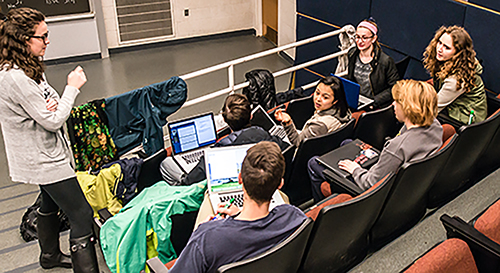How do U-M undergraduates choose their courses and majors? CRLT recently investigated this question for five LSA departments by analyzing Registrar data, surveying students, and conducting student focus groups. Our findings can help faculty and programs across the university successfully inform students about their offerings and increase the numbers of students who take advantage of them. A summary of the results and recommendations can be found here.
 Some of our key findings about students' selection processes include:
Some of our key findings about students' selection processes include:
- Above all, students use the online Course Guide (rather than printed publicity such as posters) to learn about course options. They look to departmental websites for information to help guide their decisions about concentrations.
- Other people strongly influence students' course and concentration choices. These include their academic advisors (especially in the first and second year), their peers, and their parents.
- While meeting a requirement is reported as the primary reason students choose a course, the second is an "interesting topic" -- often defined as an interdisciplinary course or a class that makes connections to future professional/educational plans.
What practices do these findings suggest if you're interested in recruiting students? Some include:
- Individual instructors can make sure the online Course Guide is up to date and includes thorough descriptions of courses. Departments can review their websites to make sure they feature easily accessible information about the concentration as well as relevant career possibilities.
- Find ways to use interpersonal connections to draw students to your courses or concentration. Publicity can include quotations from former students about the value of their experiences in the course or program. Departments can provide academic advisors with full information to help them guide students to courses and concentrations of interest. Some programs also do outreach to parents (e.g., through letters or parents' weekend activities) to make sure families accurately understand the nature of their discipline and the career possibilities associated with studying it.
- When appropriate, instructors should consider linking courses to a general or concentration requirement. Or offer cross-listed courses or thematic topics, which are often perceived by students as especially interesting.
Being clear about the outcomes of your program is not only helpful for students seeking guidance, it is also consistent with good practice in curriculum design, as emphasized by the National Academy for Academic Leadership in their materials on curriculum review. Additional resources about curriculum design and review can be found on our curriculum design page. These all include practices that can help students navigate the pathways to and through your program.
Link here to a fuller explanation of both the results of the CRLT pathways study and their implications for increasing enrollments in your courses and majors.
- Log in to post comments
- 25 views








